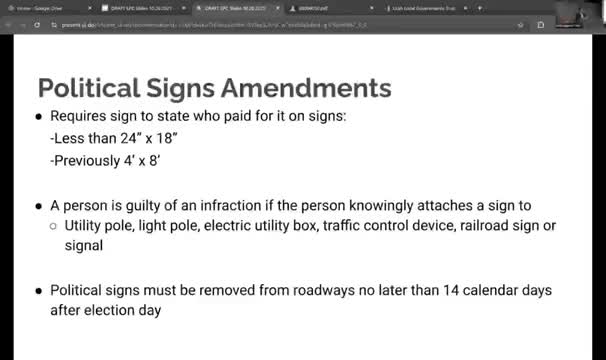Proposed elections bill would shrink required identification on signs, let municipalities store removed signs
October 24, 2025 | Utah League of Cities and Towns, Utah Lobbyist / NGO, Utah Legislative Branch, Utah
This article was created by AI summarizing key points discussed. AI makes mistakes, so for full details and context, please refer to the video of the full meeting. Please report any errors so we can fix them. Report an error »

A draft elections bill discussed Oct. 20 would change state rules for political signs, including requiring smaller signs to state who paid for them, expanding who may remove signs in restricted places, and obligating municipalities to designate a place to store signs removed from public rights-of-way.
Why it matters: Political sign rules affect local public rights-of-way, municipal enforcement, and candidate behavior during campaigns. Several legislators and League members voiced practical and legal concerns during the LPC meeting.
What the draft would do
- Disclosure on small signs: Require signs smaller than 24 by 18 inches to state who paid for them (current regulation requires identification for larger signs).
- Removal rules: Make it an infraction to knowingly attach a sign to utility poles, light poles, traffic-control devices and similar infrastructure; allow a broader set of people (including government employees) to remove such signs.
- Post-election removal and storage: Political signs on roadways must be removed within 14 calendar days after election day. Beginning Aug. 1, 2026, municipalities and counties would have to designate one or more safe-storage locations for signs removed from public rights-of-way, safeguard them for five business days, and make reasonable efforts to contact the sign owner. After five business days jurisdictions could dispose of unclaimed signs and may seek reimbursement up to $20 per sign.
Reaction from members
League staff and attendees raised logistical concerns: how municipalities would identify and contact sign owners, the administrative burden of collecting and storing signs (especially outside municipal boundaries), the risk of turning municipalities into depositories in nonmunicipal races, and whether the law would create conflicts between political and commercial sign regulation.
Park-strip signage: The draft would also prohibit municipalities from banning political signs placed in park strips when the adjacent property owner or occupant (who is responsible for maintaining the park strip) gives consent. Several members warned that allowing signs in park strips statewide could create enforcement complexity and safety questions near intersections.
Next steps
The bill was informally discussed in interim committee and held for further work. Sponsors and staff signaled they will take additional feedback before advancing language; League staff asked members to provide local examples and practical considerations.
Why it matters: Political sign rules affect local public rights-of-way, municipal enforcement, and candidate behavior during campaigns. Several legislators and League members voiced practical and legal concerns during the LPC meeting.
What the draft would do
- Disclosure on small signs: Require signs smaller than 24 by 18 inches to state who paid for them (current regulation requires identification for larger signs).
- Removal rules: Make it an infraction to knowingly attach a sign to utility poles, light poles, traffic-control devices and similar infrastructure; allow a broader set of people (including government employees) to remove such signs.
- Post-election removal and storage: Political signs on roadways must be removed within 14 calendar days after election day. Beginning Aug. 1, 2026, municipalities and counties would have to designate one or more safe-storage locations for signs removed from public rights-of-way, safeguard them for five business days, and make reasonable efforts to contact the sign owner. After five business days jurisdictions could dispose of unclaimed signs and may seek reimbursement up to $20 per sign.
Reaction from members
League staff and attendees raised logistical concerns: how municipalities would identify and contact sign owners, the administrative burden of collecting and storing signs (especially outside municipal boundaries), the risk of turning municipalities into depositories in nonmunicipal races, and whether the law would create conflicts between political and commercial sign regulation.
Park-strip signage: The draft would also prohibit municipalities from banning political signs placed in park strips when the adjacent property owner or occupant (who is responsible for maintaining the park strip) gives consent. Several members warned that allowing signs in park strips statewide could create enforcement complexity and safety questions near intersections.
Next steps
The bill was informally discussed in interim committee and held for further work. Sponsors and staff signaled they will take additional feedback before advancing language; League staff asked members to provide local examples and practical considerations.
Don't Miss a Word: See the Full Meeting!
Go beyond summaries. Unlock every video, transcript, and key insight with a Founder Membership.
✓
Get instant access to full meeting videos
✓
Search and clip any phrase from complete transcripts
✓
Receive AI-powered summaries & custom alerts
✓
Enjoy lifetime, unrestricted access to government data
30-day money-back guarantee


